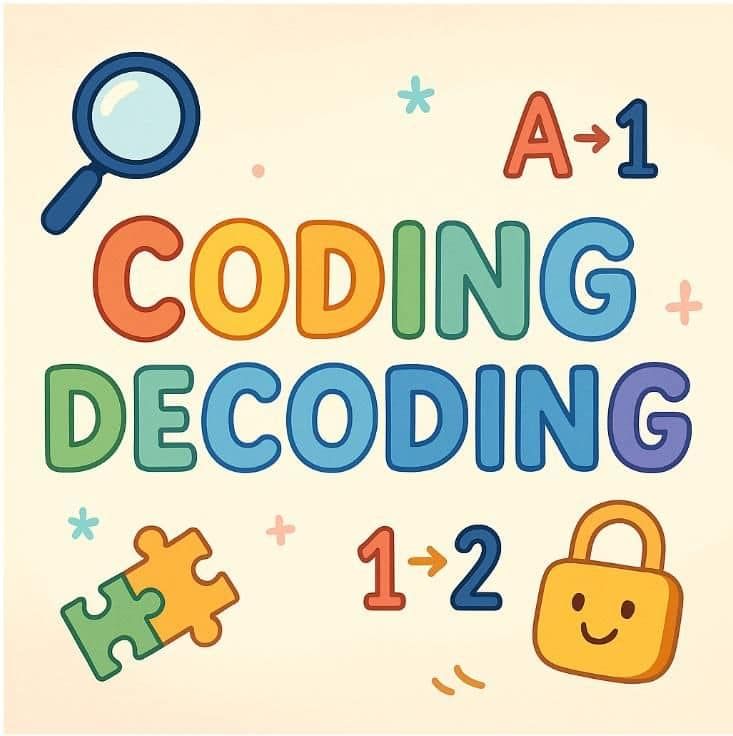Coding - Decoding | Mathematics Olympiad Class 4 PDF Download
| Table of contents |

|
| Meaning |

|
| Types of Coding-Decoding |

|
| Strategies for Solving Coding-Decoding Problems |

|
| Solved Examples |

|
Meaning
Coding-Decoding is a problem-solving technique used to encrypt or decrypt messages based on certain patterns or rules. It involves understanding the relationship between letters, numbers, or symbols and applying that knowledge to encode or decode a given message.
Types of Coding-Decoding
1. Letter Coding: Involves replacing letters of the alphabet with other letters based on a specific rule or pattern.
Rule: Move each letter one step forward in the alphabet.
A → B, B → C, C → D, …, Y → Z, Z → A
Example: “CAT” → ?
| Letter | C | A | T |
|---|---|---|---|
| +1 step → | D | B | U |
So, CAT → D B U
If A is coded as B, B is coded as C, and so on, then CAT will be coded as DBU.
2. Number Coding: Involves replacing letters with corresponding numbers based on a given rule.
Rule: Replace each letter by its position in the alphabet (A=1, B=2, …, Z=26).
| Letter | A | B | C | … | S | T | U | … | Z |
|---|---|---|---|---|---|---|---|---|---|
| Number | 1 | 2 | 3 | … | 19 | 20 | 21 | … | 26 |
Example: CAT → ?
- C → 3
- A → 1
- T → 20
So, CAT → 3–1–20
So, If A is coded as 1, B as 2, C as 3, and so on, then CAT will be coded as 3-1-20.
3. Mixed Coding: Combines both letter and number coding in a single problem.
- Example: If A is coded as B, B is coded as 2, C is coded as D, and so on, then CAT will be coded as DB3.
4. Substitution Coding: Involves replacing a group of letters with another group of letters based on a given rule.
Rule: Apply a fixed letter-to-letter substitution. Here we’ll use a +1 shift again:
| Plain | a | b | c | d | e | f | … | l | m | … | n | … |
|---|---|---|---|---|---|---|---|---|---|---|---|---|
| Code | b | c | d | e | f | g | … | m | n | … | o | … |
Example 1: apple → ?
- a → b
- p → q
- p → q
- l → m
- e → f
Result: b q q m f
Example 2: banana → ?
- b → c
- a → b
- n → o
- a → b
- n → o
- a → b
Result: c b o b o b
So, If 'apple' is coded as 'bqqmf,' then 'banana' will be coded as 'cboanb.'

Strategies for Solving Coding-Decoding Problems
Identify the Pattern:
- Analyze the given code to understand the relationship between the original message and its coded form.
- Look for recurring patterns, such as alphabetical order, numerical sequence, or reverse order.
Use Trial and Error:
- If the pattern is not immediately apparent, try applying different rules systematically to decode the message.
Look for Clues:
- Pay attention to any hints or clues provided in the problem statement that could help decipher the code.
Check for Consistency:
- Ensure that the same rule is applied consistently throughout the coding or decoding process.
Solved Examples
(i) If 'PENCIL' is coded as 'QFODJM,' how is 'PAPER' coded?
Sol: Shift each letter one step forward (A→B, B→C, …).
To code PAPER:
- P → Q
- A → B
- P → Q
- E → F
- R → S
Answer: PAPER → QBQFS
(ii) If 'RIVER' is coded as '12341' and 'CLOUD' is coded as '56789,' how is 'CIDER' coded?
Sol: Each letter is replaced by a specific digit (learned from the two examples):
- From RIVER → 1 2 3 4 1 we get R=1, I=2, V=3, E=4
- From CLOUD → 5 6 7 8 9 we get C=5, L=6, O=7, U=8, D=9
To code CIDER:
- C → 5
- I → 2
- D → 9
- E → 4
- R → 1
Answer: CIDER → 52941
(iii) If 'HOUSE' is coded as 'GNTRD,' what is the code for 'BRICK'?
Sol: Rule: Shift each letter one step backward (A←B, B←C, …).
To code BRICK:
- B → A
- R → Q
- I → H
- C → B
- K → J
Answer: BRICK → AQHBJ
|
33 videos|98 docs|48 tests
|
FAQs on Coding - Decoding - Mathematics Olympiad Class 4
| 1. What is the meaning of coding-decoding in the context of competitive exams? |  |
| 2. What are the different types of coding-decoding methods commonly used in exams? |  |
| 3. What strategies can be employed to solve coding-decoding problems effectively? |  |
| 4. Can you provide an example of a coding-decoding problem and its solution? |  |
| 5. Why is coding-decoding important in competitive exams? |  |















